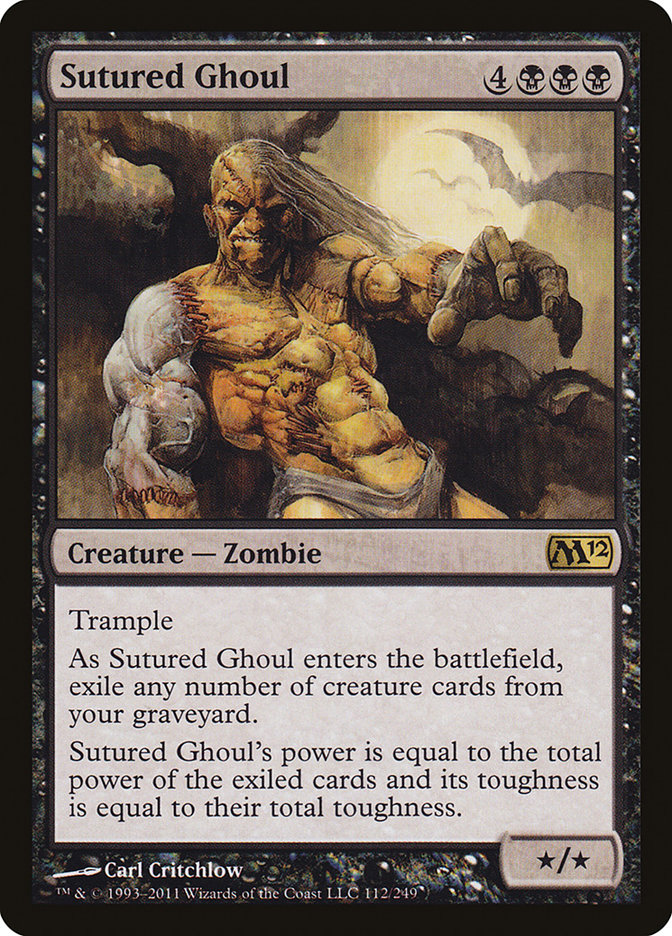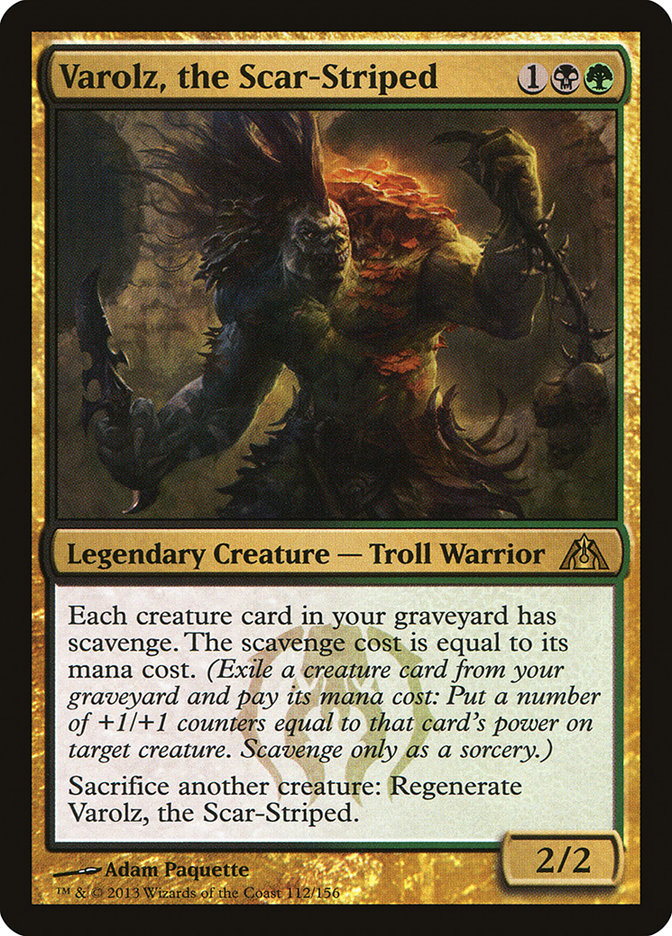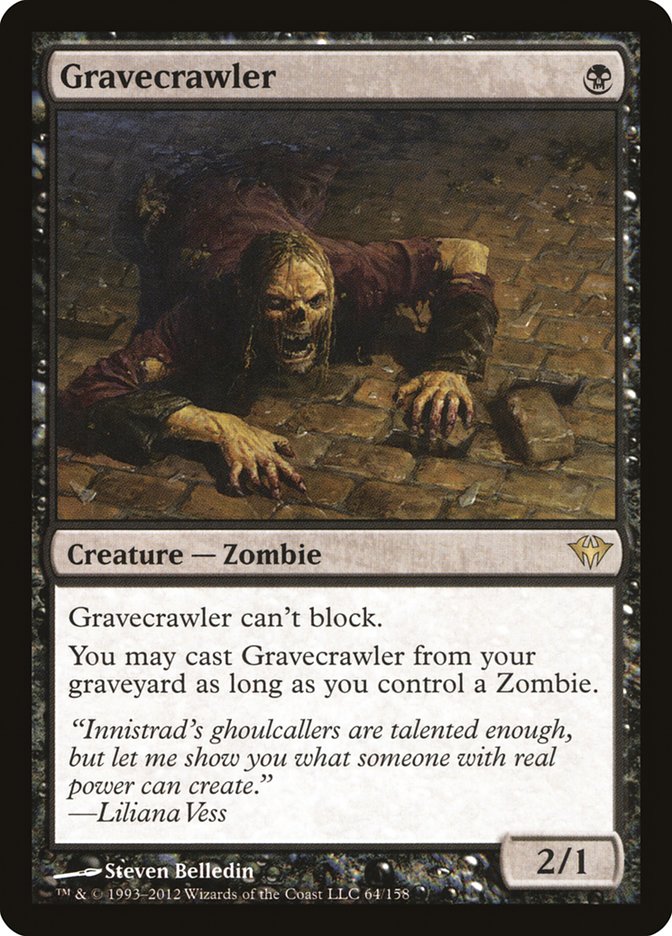The single best part of non-Standard formats is seeing how new cards recontextualize old cards. For years, Dark Depths was nothing. It was a thirty-mana 20/20. When Vampire Hexmage was printed, Dark Depths became so good in Extended that it was never allowed to rear its head in the new Modern format.
When Brainstorm was originally printed, it was fine. It wasn’t great, but it had some synergy with Impulse. When the Onslaught fetchlands were printed, Brainstorm became one of the best cards in Vintage and the undisputed best card in Legacy.
Now, we have Alesha, Who Smiles at Death. People have long been conditioned to look at the creatures with the highest available power for inspiration on what to bring back from the dead. The creatures that can’t stay in the graveyard tend to be the ones with the highest power and toughness – the Eldrazi, Progenitus, Darksteel Colossus, Blightsteel Colossus, and so on – precisely because of this heuristic.
Alesha inverts that: suddenly the things you want to look at are completely different. Alesha doesn’t smile at Griselbrand, but Griselbrand isn’t the only creature worth reanimating.
Ever since Golgari Grave-Troll was unbanned in Modern, I’ve been interested to see what people come up with. After all, the card isn’t just the best-rate dredger: it’s an awesome creature to bring back from the dead. If Dread Return were legal, our deck would be built for us – we would have Narcomoeba, Bridge from Below, Bloodghasts, Gravecrawlers, and spells that draw multiple cards so that we can dredge for dozens of cards a turn to create an overwhelming edge.
Unfortunately for Modern aficionados, everyone who’s working on Modern is tight-lipped in anticipation of this weekend’s Modern Pro Tour in Washington, D.C. Since I’m not qualified for the Pro Tour, I have no compunction about writing this article. I’m not exactly working with a Modern team, so I make no promises about this winning the tournament, but I do think it’s a sweet deck that can compete with what the format has going on.
Without Dread Return, the dominant conception of a competitive graveyard deck is one that emphasizes Vengevine. It looks a lot like Ichorid – has haste, free to bring back, keeps coming back to grind out removal-heavy opponents, asks you to play a lot of creatures – so the impetus is on any graveyard-based deck to demonstrate why they don’t want four Vengevines.
I think that Vengevine is fine as a long-game plan, but Alesha, Who Smiles at Death excites me even more as a “fast” game.

When I started brewing with Alesha, my first thought was “oh, bring back Golgari Grave-Troll, it’ll be an 8/8 that regenerates, that’s really good”, I quickly realized that I was aiming low. We can do better.
For instance, how about this?

Master of Cruelties is prohibitively costed, no doubt. Fortunately for the Master, Alesha can work around that weakness. If our opponent is playing a creatureless combo deck, they die on the spot to Alesha bringing back Master of Cruelties: Master triggers upon not being blocked, taking them to one, and Alesha still connects for the coup de grace.
But what if they have some creatures? Affinity, for instance, can easily afford to leave a Signal Pest or a Vault Skirge back to throw under the bus while clocking us back with Arcbound Ravager and friends. Master of Cruelties may do a good impression of The Abyss once it’s on the board, but it also forces us to sideline Alesha for future combat steps. Enter Sutured Ghoul:

When Sutured Ghoul is in your graveyard, its power and toughness are 0/0. When it’s in play, they can be anything. For instance, how’s this for food?


With this setup, Alesha can basically act as a Sneak Attack for something even bigger than Emrakul, the Aeons Torn – not bad, assuming you’re okay with putting some blank cardboard in your deck with the express purpose of exiling it to Sutured Ghoul.
Of course, we’ve moved quite a bit beyond the original Krosan Cloudscraper in terms of card text. If we want some good old fashioned power and toughness, we can even buy card text:

Always a 13/13 when not in play, Death’s Shadow can do a much better Cloudscraper impression while also playing much, much nicer with another graveyard-based payoff: Varolz, the Scar-Striped.

A creatures-and-lands-only version of this deck made the Top 16 of the Modern Premier IQ in Indianapolis this past weekend. It has a number of slower angles that I don’t like (Skaab Ruinator, for instance), but it can serve as a good starting point for what we want to do:
Creatures (40)
- 4 Birds of Paradise
- 3 Golgari Grave-Troll
- 4 Bloodghast
- 4 Hedron Crab
- 4 Death's Shadow
- 4 Vengevine
- 2 Fauna Shaman
- 4 Skaab Ruinator
- 4 Gravecrawler
- 4 Lotleth Troll
- 3 Varolz, the Scar-Striped
Lands (20)
Sideboard

It’s pretty clear that we want to be Jund with this deck. Alesha is red, the format-legal Careful Study (Faithless Looting) is red, and obvious Affinity hoser Ancient Grudge is red. If we want to go hard on draw power, we can get something like Burning Inquiry for pretty cheap, so red is a great color to be in.
Green and black are pretty clear inclusions once you know that you want to be playing dredge cards – they have the good dredgers, they have good discard outlets, Varolz is green and black – the list goes on. The only real color-related question I’ve seen regarding in any Dredge-style deck is “Jund, Sultai, or both?” For now, let’s commit to Jund.
The first question we need to ask ourselves is “how can we consistently have a dredger in our graveyard?” Without that going on, we’re going to be spinning our wheels and drawing useless cards a lot of the time. Fortunately, Travis Woo has done a lot of the legwork for us: the best discard outlets in Modern are M12 reprint Zombie Infestation and Return to Ravnica Wild Mongrel-lookalike Lotleth Troll. Both of them provide an endless way to instantly discard cards for value and both of them create a board with a Zombie on it. Why is the second part important?

Although Bloodghast is most peoples’ first thought when it comes to Dredge, Gravecrawler is by far the superior creature. At the point where you know that you want to play quads Vengevine, being able to cast two Gravecrawlers from your graveyard to trigger them is a huge boon. Bloodghast, while usually free, isn’t as handy as Gravecrawler. We don’t have a ton of ways to make use of a recursive 2/1 without Dread Return, and we can get a better rate on a lot of our two-drops. Narcomoeba is similarly free, for instance, but I have a strong feeling that we won’t be playing any of those.
If you put all of these cards into a decklist, you’re looking at 38 spells:
4 Alesha, Who Smiles at Death
2 Sutured Ghoul
4 Varolz, the Scar-Striped
4 Golgari Grave-Troll
4 Stinkweed Imp
4 Gravecrawler
4 Vengevine
4 Death’s Shadow
4 Zombie Infestation
4 Lotleth Troll
There are a number of notable exclusions from this draft decklist, most prominently Thoughtseize and Faithless Looting. At the point where we’re a value deck rather than a Flashback-heavy attrition-oriented deck, I don’t know that I want a Careful Study in the deck. Looting does a lot to speed the deck up, but Zombie Infestation gets us onto the board against more aggressive decks and keeps our options open as to whether we want Death’s Shadow or Vengevine or Golgari Grave-Troll in our hand. After all, a five-mana regenerating 8/8 is no slouch, and you don’t always want to dredge in this deck.
Thoughtseize is an easier exclusion: we don’t care about a lot of what our opponent is doing. Kill our creature? Sure, here’s another. Thoughtseize us? Sure, we get to draw a card every turn. Cast a creature? Don’t care, mine are going to be bigger. The only spot where Thoughtseize is going to be good is against a combo deck, and jamming four Thoughtseizes into this kind of maindeck is going to dilute all of the synergies more than it’s going to help out.
Some basic rules for you:
- Alesha returns Sutured Ghoul and Golgari Grave-Troll with counters. Grave-Troll counts itself.
- Casting Gravecrawler from your graveyard counts as a creature spell for Vengevine.
- Yes, Scavenging away a Death’s Shadow provides 13 +1/+1 counts for a single black mana.
That’s about it. It’s not the most complicated deck in the world from a rules perspective. The manabase is a little tougher, mostly because you want enough fetchlands and shocklands to be able to self-damage into Death’s Shadow-being-a-card territory, but you also don’t want to take three damage every time you put a land into play.
Given that we’re playing with 22 lands, here was my thought process when putting together the manabase:
- We’re not playing Life from the Loam, so nothing too fancy.
- We definitely want at least one basic Swamp and one basic Forest to beat Blood Moon and to have painless mana on any given turn.
- We want a lot of Overgrown Tombs, since our deck wants black mana right away and in quantity for everything from Gravecrawler to Scavenging away Death’s Shadow to activating Alesha, while it wants reliable green mana on turns two and three for Lotleth Troll and Varolz.
- Red mana is basically just for Alesha in game ones, but we’re going to want Ancient Grudges in the sideboard, so don’t skimp on being able to find red mana. We’re only really going to need one red source, so we don’t need to jam our deck full of them.
- The natural conclusion to the previous two statements is that we’re going to play a lot of fetchlands.
- We also don’t want to play one or two red sources and dredge them both away. Realistically, we want four real red sources.
- We want all of our mana to enter the battlefield untapped. We have plays all the way up the curve, we have a lot of mana sinks already, and we don’t need things like Raging Ravine to pay us back on value. This deck doesn’t flood much at all.
- Since we care more about black mana in quantity than green, our red sources are going to be 3 Blood Crypt and 1 Stomping Ground. If Affinity is too rough of a matchup, consider changing a Crypt to a basic Mountain, but understand that that comes at the cost of basically an entire land slot in the early game of other matchups. Lotleth Troll doesn’t play in the Mountains.
- We’re currently looking at 4 red sources, 2 non-red basics, and 4 Overgrown Tombs. Since we’re going to want mostly black mana going long, we can reasonably play an Urborg, Tomb of Yawgmoth to preserve life on fetchlands in the late game.
- This leaves us with eleven fetchlands. The correct ones (obviously) are Verdant Catacombs, Bloodstained Mire, and Wooded Foothills. In a world where we care about finding a basic land more, it’s probably going to do more with life total considerations, so green mana (to Flashback Ancient Grudge) edges out black mana, ergo 4 Foothills and 3 Mire.
–
The manabase, then:
4 Verdant Catacombs
4 Wooded Foothills
3 Bloodstained Mire
4 Overgrown Tomb
3 Blood Crypt
1 Stomping Ground
1 Swamp
1 Forest
1 Urborg, Tomb of Yawgmoth
There is a reasonable chance that this manabase is “too good” – that is, it overserves the needs of specific colored mana requirements at the expense of life points – but I haven’t played nearly the number of games to know whether that’s true and, if so, to what extent. I do know that this manabase functions well in games and is a bit soft to Lava Spike. Proceed at your own risk.
The sideboard for this deck is pretty fun. Since most peoples’ graveyard hate is stuff like Grafdigger’s Cage and Scavenging Ooze rather than Relic of Progenitus or Tormod’s Crypt, we don’t need to worry about people wholesale nuking our graveyard. This means that we can still exploit our Dredge cards, albeit from a different angle. To wit:
4 Tombstalker
3 Abrupt Decay
3 Ancient Grudge
2 Gnaw to the Bone
3 Thoughtseize
Gnaw to the Bone makes an appearance because I don’t expect any burn deck to mess around with graveyard hate. If they do, I would be overjoyed to face one fewer Rift Bolt in that game.
Ancient Grudge is pretty basic. They have artifacts, your clock is slower than their clock. Target Cranial Plating. Try not to take damage from your lands.
Thoughtseize is also pretty basic. They have spells, you want to slow down their spell-based combo deck. If you’re boarding in Thoughtseize, you should have a pretty clear idea of what you want to take with Thoughtseize. If not, don’t board it in.
Abrupt Decay is a catch-all. On a very basic level, it’s a two-mana removal spell that slows down the most aggressive decks in the format. Beyond that, it’s there against G/B/x decks as a way to either go after graveyard-antagonistic cards like Scavenging Ooze or just to punch through a fragile board position as a straightforward removal spell. Since the matchup against G/B/x decks is very board-focused and goes long, Abrupt Decay is never going to be dead and can be situationally stellar. Abrupt Decay is obviously also quite good against Jeskai Ascendancy and Pyromancer Ascension, but you already knew that.
Tombstalker is the “cute” part of the sideboard. At the point where people are playing Siege Rhino and Tarmogoyf, Tombstalker can tag in for Gravecrawler and go over the top. There are already a ton of juicy targets for Path to Exile in this deck, so it’s not a lock that the 5/5 flier is dead on arrival. On a tactical axis, if people are actively trying to hate out the Alesha + Sutured Ghoul angle, Tombstalker forces them to react. It’s a pretty basic sideboard semi-transformation, but it holds a lot of promise in this deck because of how hard we can dredge and how useless most of the cards are once they’re in the graveyard.
All together now:
Creatures (34)
- 2 Sutured Ghoul
- 4 Golgari Grave-Troll
- 4 Stinkweed Imp
- 4 Death's Shadow
- 4 Vengevine
- 4 Gravecrawler
- 4 Lotleth Troll
- 4 Varolz, the Scar-Striped
- 4 Alesha, Who Smiles at Death
Lands (22)
Spells (4)
Sideboard

Tasigur isn’t in the deck because I don’t love the idea of milling a few cards, getting back a Death’s Shadow or Zombie Infestation, then shipping the turn back. If you want to play Tasigur, you should be interacting with your opponent a lot more than this deck does.
If this deck doesn’t strike your fancy, don’t worry – I’ve got more.
BONUS DECKLISTS
Creatures (31)
- 4 Nantuko Husk
- 4 Golgari Grave-Troll
- 3 Stinkweed Imp
- 4 Bloodghast
- 4 Vengevine
- 4 Gravecrawler
- 4 Lotleth Troll
- 4 Alesha, Who Smiles at Death
Lands (23)
Spells (6)

Creatures (9)
Lands (25)
Spells (26)


